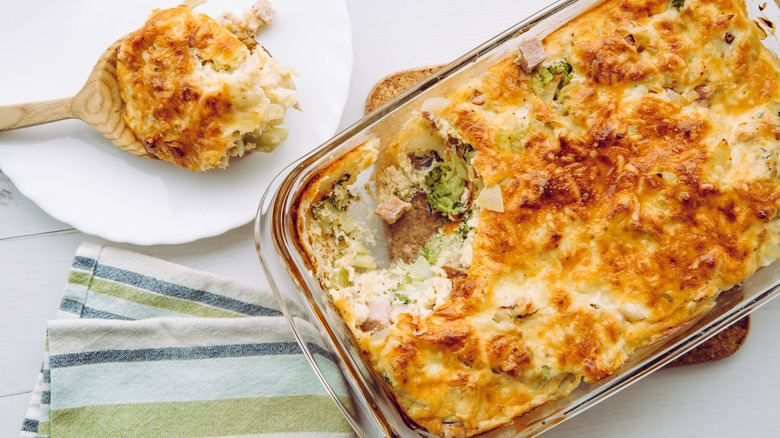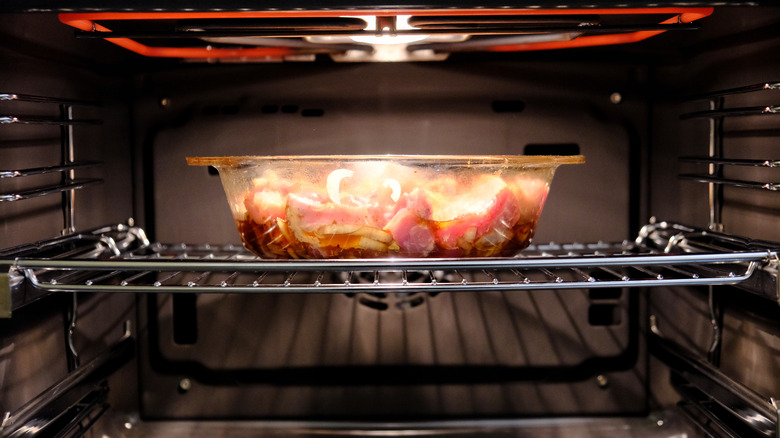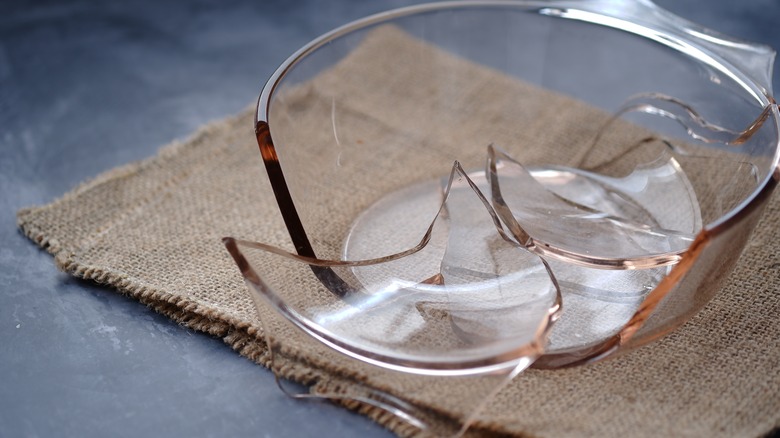The Vital Tip You Need To Know About Using Glassware In The Oven
It's happened to many a home cook. You arrange your casserole in a beautiful glass dish for cooking, perfect for taking straight from the oven to the dining table with no need for extra serving-ware. But when the timer goes off and you open the oven, the chicken is overcooked or the breading is underdone. It doesn't make any sense, though you followed the recipe exactly. So you start scouring through the cookbook for mistakes or examining your oven for flaws (or maybe you just give up and order pizza). Most likely, though, it isn't a matter of technical malfunction or even human error. The problem was your glassware.
Truth be told, it isn't really a problem. Glass cookware, like Pyrex and Anchor Hocking, is quite a useful cooking tool. You can see through it to check for crispiness, it has natural nonstick qualities, and it won't react to acidic foods like tomatoes or lemon. But it does require some adjustment in method. If you're cooking with glassware, the general rule of thumb is that you should lower the prescribed oven temperature by 25 degrees Fahrenheit.
Taking conduction and insulation into account
Baking instructions tend to assume metal, which is a conductor of heat, whereas glass is an insulator. This means that glass will take a longer time to heat up than metal, but once it gets up to temperature, it stays hot for longer. So lowering the oven's temperature by 25 degrees Fahrenheit will lead to more accurate baking; some experts also suggest extending the bake time by about 10 minutes.
Glassware is useful for being able to check on the exteriors of sheet pan dinners, casseroles, or pies — getting beautifully browned crusts, and baking acidic ingredients without reaction, but its insulating qualities can make certain dishes — like cakes and breads — more challenging. Because it heats up slowly and stays hot, the bake can be uneven, with overcooked outside layers and raw interiors. Adjusting the oven temperature certainly helps with this problem, but if you want to ensure an evenly cooked final product, you might need to avoid glass dishes when baking a cake.
Make sure you're using it safely
Glass bakeware requires instructions beyond lowering oven temperature. Even though makers of it have emphasized safety, it comes with an inherent risk of shattering, so it's always important to consider the best use cases. The main things to avoid are stark changes in temperature. This means: don't take your casserole out of the oven then immediately toss the glass pan into the sink to wash, and don't pull the pan out of the fridge or freezer and stick it straight in a hot oven. Trivets, potholders, and cooling racks are kitchen essentials for a reason. Hot glass also shouldn't go directly on a countertop, stovetop, or any cool or wet surface.
Further, if you're cooking something that requires basting, don't use cool liquid. Even if it's already in the oven, liquids warm slowly, and a differential between the inside and outside of a dish can form in a hurry. Pyrex's own website points out to, "add a small amount of liquid sufficient to cover the bottom of the dish prior to cooking foods that may release liquid." Also heed this advice if your ingredients don't fill the entire pan; going with broth rather than water will ensure some added flavor as the pan boils it off. Whether you're angling for an even bake or just avoiding a kitchen accident, temperature is a crucial consideration for glassware because, unlike metal, it has no plans to expand or contract.


